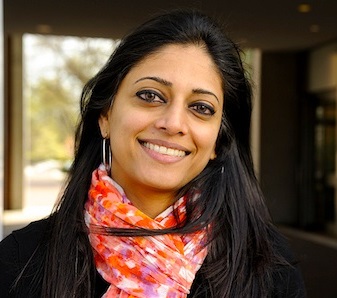We are delighted to have with us as distinguished plenary speakers:
 |
Jennifer Tour Chayes, Managing Director, Microsoft Research New England & Microsoft Research New York City. The Power of Locality for Network Algorithms Abstract. Given the massive size of many networks, conventional algorithms which scale as polynomials in the network size are woefully inadequate. In the first part of this talk, we consider how to use locality to deliver much more efficient algorithms (quasi-linear or even sub-linear in the network size) for quantities and questions like pagerank, coverage, diffusion, and determining the most influential nodes. In the second part of this talk, we consider another aspect of locality, namely the question of local data access. Many large networks are encoded locally, e.g., with adjacency lists. How does the nature of the data access impact the efficiency of algorithms? Surprisingly, we show that small differences in data access can lead to very large differences in efficiency and approximability of network algorithms. As an example, we consider a covering problem which arises naturally for recruiters on social networks, and show how small differences between the information on neighbors in LinkedIn and Facebook lead to large differences in their utility to recruiters. (Shortened) Biography. Jennifer Tour Chayes is Distinguished Scientist, Managing Director and Cofounder of Microsoft Research New England and Microsoft Research New York City. Before joining Microsoft in 1997, Chayes was for many years Professor of Mathematics at UCLA. Chayes is the author of over 125 academic papers and the inventor of over 30 patents. Her research areas include phase transitions in discrete mathematics and computer science, structural and dynamical properties of self-engineered networks, graph theory, graph algorithms, algorithmic game theory, and computational biology. Chayes holds a BA in biology and physics from Wesleyan, where she graduated first in her class, and a PhD in mathematical physics from Princeton. She did postdoctoral work in the Mathematics and Physics Departments at Harvard and Cornell. She is the recipient of an NSF Postdoctoral Fellowship, a Sloan Fellowship, the UCLA Distinguished Teaching Award, and the ABI Women of Leadership Vision Award. She has twice been a member of the IAS in Princeton. Chayes is a Fellow of the American Association for the Advancement of Science, the Fields Institute, the Association for Computing Machinery, and the American Mathematical Society, and an Elected Member of the American Academy of Arts and Sciences. |
 |
Ramesh Johari, Associate Professor, Management Science and Engineering, Stanford University. Can I Take a Peek? Continuous Monitoring of Online A/B Tests Abstract. A/B testing is a hallmark of Internet services: from e-commerce sites to social networks to marketplaces, nearly all online services use randomized experiments as a mechanism to make better business decisions. Such tests are generally analyzed using classical frequentist statistical measures: p-values and confidence intervals. Despite their ubiquity, these reported values are computed under the assumption that the experimenter will not continuously monitor their test---in other words, there should be no repeated “peeking” at the results that affects the decision of whether to continue the test. On the other hand, one of the greatest benefits of advances in information technology, computational power, and visualization is precisely the fact that experimenters can watch experiments in progress, with greater granularity and insight over time than ever before. We ask the question: if users will continuously monitor experiments, then what statistical methodology is appropriate for hypothesis testing, significance, and confidence intervals? We present recent work addressing this question. In particular, building from results in sequential hypothesis testing, we present analogues of classical frequentist statistical measures that are valid even though users are continuously monitoring the results. Joint work with Leo Pekelis and David Walsh. (This work was carried out with Optimizely, a leading A/B testing platform.) Biography. Ramesh Johari is an Associate Professor at Stanford University and the Cisco Faculty Scholar in the School of Engineering, with a full-time appointment in the Department of Management Science and Engineering (MS&E), and courtesy appointments in the Departments of Computer Science (CS) and Electrical Engineering (EE). He is a member of the Operations Research group in MS&E, the Information Systems Laboratory in EE, and the Institute for Computational and Mathematical Engineering. He received an A.B. in Mathematics from Harvard (1998), a Certificate of Advanced Study in Mathematics from Cambridge (1999), and a Ph.D. in Electrical Engineering and Computer Science from MIT (2004). |
 |
Sridevi V. Sarma, Assistant Professor of Biomedical Engineering, Institute for Computational Medicine, Johns Hopkins University. On the Therapeutic Mechanisms of Deep Brain Stimulation for Parkinson’s disease: Why High Frequency? Abstract. Deep brain stimulation (DBS) is clinically recognized to treat movement disorders in Parkinson’s disease (PD), but its therapeutic mechanisms remain elusive. One thing is clear though: high frequency periodic DBS (130-180Hz) is therapeutic, while low frequency DBS is not therapeutic and may even worsen symptoms. So, what is so special about high frequency? In this talk, we address this question by discussing our viewpoint supported by recent results from our key studies of the thalamo-cortical-basal ganglia motor network. First, thalamic cells play a pivotal role in performing movements by selectively relaying motor-related information back to cortex under the control of modulatory signals from the basal ganglia (BG). Through computational models of thalamic cells, systems theory and analysis, and single unit recordings from primates, we show that (i) there is a set of BG signals ("Proper Relay Set", PRS), under which the thalamic cells can reliably relay the motor commands, and that (ii) the BG signals belong to the PRS in healthy conditions but are outside the PRS under PD conditions. Then, we use a detailed computational model of the motor network under PD conditions to study the effects of DBS on the BG signals projecting to the thalamic cells. We show that high frequency periodic DBS steers the BG signals back to the PRS while lower frequency regular DBS and irregular DBS do not. Furthermore, we show that DBS pulses evoke inputs that propagate through the motor circuit both orthodromically (i.e., forward) and antidromically (i.e., backward) and fade away within a few milliseconds, thus having little effects on the BG signals. However, when the latency between consecutive DBS pulses is small (i.e., DBS is high frequency) and constant over time (i.e., DBS is periodic), then orthodromic and antidromic effects overlap in the loop and result in a strong, long-lasting perturbation that ultimately drives the BG signals back to the PRS. Taken together, these results provide a holistic view of motor control in healthy and PD conditions, account for the neural mechanisms of therapeutic DBS, and suggest that the merit of DBS critically depends on loop delays in the closed-loop thalamo-cortical-basal ganglia system. Biography. Sridevi V. Sarma (M’04) received the B.S. degree in electrical engineering from Cornell University, Ithaca NY, in 1994; and an M.S. and Ph.D. degrees in Electrical Engineering and Computer Science from Massachusetts Institute of Technology in, Cambridge MA, in 1997 and 2006, respectively. She was a Postdoctoral Fellow in the Brain and Cognitive Sciences Department at the Massachusetts Institute of Technology, Cambridge, from 2006-2009. She is now an assistant professor in the Institute for Computational Medicine, Department of Biomedical Engineering, at Johns Hopkins University, Baltimore MD. Her research interests include modeling, estimation and control of neural systems using electrical stimulation. She is a recipient of the GE faculty for the future scholarship, a National Science Foundation graduate research fellow, a L’Oreal For Women in Science fellow, the Burroughs Wellcome Fund Careers at the Scientific Interface Award, the Krishna Kumar New Investigator Award from the North American Neuromodulation Society, and a recipient of the Presidential Early Career Award for Scientists and Engineers (PECASE). |
 |
Martin Wainwright, Professor of Electrical Engineering and Computer Science, Professor of Statistics UC Berkeley. Statistics meets Computation: Some vignettes from the interface Abstract. In the modern era of massive data sets, computational considerations have become increasingly important in statistics. In this talk, we discuss some problems that lie at the interface between statistics and algorithms, including rigorous guarantees for non-convex optimization problems in statistics, and various forms of optimality in randomized sketching methods Biography. Martin Wainwright joined the faculty at University of California at Berkeley in Fall 2004, and is currently a Professor with a joint appointment between the Department of Statistics and the Department of Electrical Engineering and Computer Sciences. He received his Bachelor's degree in Mathematics from University of Waterloo, Canada, and his Ph.D. degree in Electrical Engineering and Computer Science (EECS) from Massachusetts Institute of Technology (MIT), for which he was awarded the George M. Sprowls Prize from the MIT EECS department in 2002. He is interested in high-dimensional statistics, information theory and statistics, and statistical machine learning. He has received an Alfred P. Sloan Foundation Research Fellowship (2005), IEEE Best Paper Awards from the Signal Processing Society (2008) and Communications Society (2010); the Joint Paper Award from IEEE Information Theory and Communication Societies (2012); a Medallion Lecturer (2013) of the Institute for Mathematical Statistics; a Section Lecturer at the International Congress of Mathematicians (2014); and the COPSS Presidents' Award in Statistics (2014). He is currently serving as an Associate Editor for the Annals of Statistics, Journal of Machine Learning Research, Journal of the American Statistical Association, and Journal of Information and Inference. |


 Massachusetts Institute of Technology
Massachusetts Institute of Technology